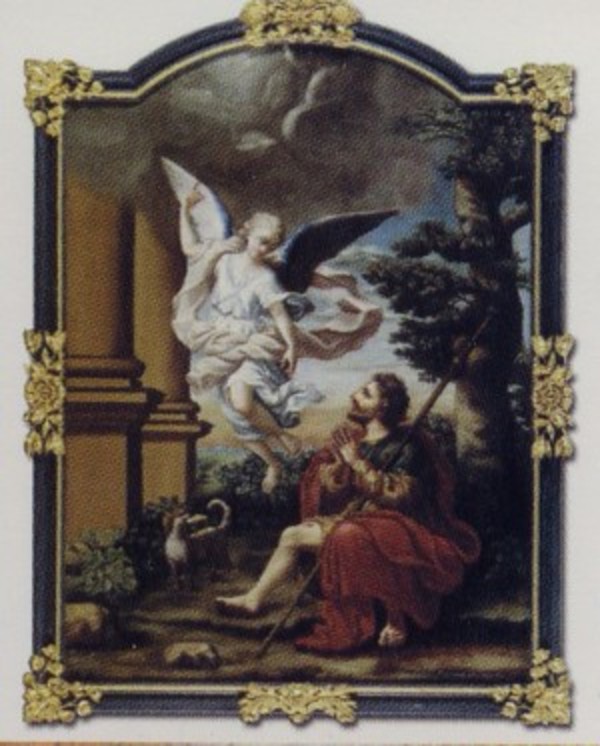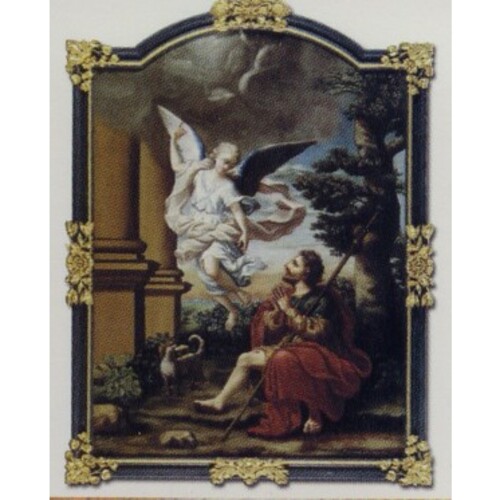
Source: Link
AIDE-CRÉQUY, JEAN-ANTOINE, parish priest and artist; b. 5 April 1749 at Quebec, son of Louis Aide-Créquy, a mason, and Marie-Hélène Lefebvre; d. 6 Dec. 1780 at Quebec.
Jean-Antoine Aide-Créquy was educated, at least in part, at the Séminaire de Québec: the seminary records note under the date 18 Nov. 1768, “it has been decided that . . . Créquy should enter [his year of] philosophy next Easter if [he is] ready.” He received the tonsure in the chapel of the seminary on 7 Dec. 1771 and minor orders two weeks later. Made subdeacon in 1772 and deacon the following year, he was ordained priest on 24 Oct. 1773 and given responsibility for the parish of Baie-Saint-Paul, to which he went at the beginning of November. Bishop Briand approved of Aide-Créquy’s appointment to this parish, which since the death of its priest in 1771 had been ministered to by Jean-Jacques Berthiaume, parish priest of Les Éboulements and Île aux Coudres. On 8 Nov. 1773 Briand wrote to Father Berthiaume: “I was very glad that Providence sent you M. Créquy as your neighbour; he is a reliable man and, I hope, will be a good priest and a dedicated missionary; [also] because I knew you liked him and had ties with his family; now I can rest content about this corner of my diocese which has always caused me a good deal of anxiety.” In addition to the parish of Baie-Saint-Paul, Abbé Aide-Créquy was to look after the mission of Saint-François-Xavier-de-la-Petite-Rivière. As early as 22 Dec. 1773 he informed the bishop that he intended to build a new church for his parish which would incorporate the reredos of the existing church. This project in fact was completed five years later.
Aide-Créquy’s correspondence with Bishop Briand reveals that he had little concern for his own comfort, being content with the bare necessities of life; he took a genuine interest in parish affairs and had great sympathy for his parishioners. He was the first parish priest to keep regular accounts for Baie-Saint-Paul. He provided a bell for his church and bought a small boat so that he could go to Petite-Rivière. His sacristan and factotum, Élie Mailloux, appears to have been an educated, intelligent man. In 1777 Aide-Créquy acted as middleman between the priests of the Séminaire de Québec and the labourers who were repairing its mill at Baie-Saint-Paul. The seminary granted some land to his parish council in exchange. In ill health, the young priest left his parish in June 1780; on 6 December, in retirement at Quebec, he died prematurely.
Always in precarious health, Aide-Créquy had perhaps overestimated his own strength in dedicating himself not only to his ministry but also to painting. As an artist he tried to meet the needs of parishes and communities now unable to import religious works from France. In particular, he executed a number of large paintings for neighbouring parishes. Their needs were no doubt an important stimulus to the development of both his art and his career. All his paintings have religious subjects, inspiration having come from engravings or paintings to which he had access in the colony. In his brief career he produced a respectable number of artistic works of which a dozen are known today. The earliest, Vierge à l’enfant, which is in the Hôtel-Dieu of Quebec, was painted in 1774. His large paintings include Vision de sainte Angèle (1775) in the Ursuline convent of Quebec, an Annonciation (1776) in the church at L’Islet, Vision de saint Roch (1777) in the church of Saint-Roch-des-Aulnaies, Saint Louis tenant la couronne d’épines, done in 1777 for the church of Saint-Louis on Île aux Coudres and now kept in the bishop’s palace in Chicoutimi, and Saint Joachim offrant la Vierge au Très-Haut (1779) in the church at Saint-Joachim. For the latter parish he may have painted two other works which are supposed to have been replaced in 1869 by works of Antoine Plamondon*. Two others were destroyed by fires: Sainte Famille at Notre-Dame cathedral in Quebec in 1866, and Saint Pierre et saint Paul in the Baie-Saint-Paul church in 1962. Two paintings in the Hôtel-Dieu of Quebec, Saint Pierre and Saint Paul, are also attributed to him.
Aide-Créquy was skilful at presenting persons in paintings in effective relief, his scenes had good perspective, and he could catch the play of light and shade. His sense of colour was usually sure, his brush strokes deft, and his handling of impasto well judged. The paintings drawn from engravings were often more expressive than the engravings themselves. These technical and pictorial characteristics make it impossible to accept the hypothesis that Aide-Créquy was self-taught. It is quite likely he received his training before he became a priest. He was not always successful, however, in blending elements taken from different paintings into a happy composition, and in devising backgrounds himself he showed a taste for heavy architectural settings. It must be emphasized that he was not a slavish imitator. Abbé Charles Trudelle’s comment is a valid assessment: “He was not a Raphaël, yet one can see that he had taste and aptitude for his art.”
AAQ, 12 A, C, 124–25, 137, 139; 61 CD, Les Éboulements, I, 13; Baie-Saint-Paul, I, 7–8. ANQ-Q, État civil, Catholiques, Notre-Dame de Québec, 6 avril 1749, 8 déc. 1780. Archives paroissiales, Saints Pierre et Paul (Baie-Saint-Paul, Qué.), Charles Trudelle et al., “Recueil de lettres et de notes concernant la paroisse de la Baie St Paul, 1859 . . . ,” 18–20, 330–31, 334–35 (manuscrit). ASQ, mss, 13, 1l oct., 18 nov. 1778; Séminaire, 152, nos.368, 379a. IBC, Centre de documentation, Fonds Morisset, Dossier J.-A. Aide-Créquy. Allaire, Dictionnaire, I, 8. Canada, an encyclopædia of the country: the Canadian dominion considered in its historic relations, its natural resources, its material progress, and its national development, ed. J. C. Hopkins (6v., Toronto, 1898–1900), IV, 354. P.-V. Charland, “Notre-Dame de Québec: le nécrologe de la crypte,” BRH, XX, 244. J. R. Harper, Early painters and engravers in Canada (Toronto, [1971]). Musée du Québec, Peinture traditionnelle du Québec (Québec, 1967), 10–11. Thomas O’Leary, Catalogue of the Chateau Ramezay museum and portrait gallery (Montreal, 1901), 35. P.-G. Roy, Fils de Québec, II, 86–87. Tanguay, Dictionnaire. Claude Thibault, Trésors des communautés religieuses de la ville de Québec (Québec, 1973), 37–38, 88. Treasures from Quebec (Ottawa and Quebec, 1965), no.56. Léon Bélanger, L’église de L’Islet, 1768–1968 (L’Islet, Qué., 1968), 49–50. [Georges Bellerive], Les Éboulements et l’Île-aux-Coudres; souvenirs et impressions d’écrivains sur ces deux beaux endroits historiques (s.1., s.d.),11. Léonce Boivin, Dans nos montagnes (Charlevoix) (Les Éboulements, Qué., 1941), 115. Jean Des Gagniers, L’Île-aux-Coudres ([Montréal], 1969), 76–79. J. R. Harper, La peinture au Canada des origines à nos jours (Québec, 1966), 37–39. Alexis Mailloux, Histoire de l’Île-aux-Coudres depuis son établissement jusqu’à nos jours, avec ses traditions, ses légendes, ses coutumes (Montréal, 1879), 61; Promenade autour de l’Île-aux-Coudres (Sainte-Anne-de-la-Pocatière [La Pocatière], Qué., 1880), 52. Gérard Morisset, Coup d’œil sur les arts, 54; Peintres et tableaux (Québec, 1936), I, 67–69; La peinture traditionnelle au Canada français (Ottawa, 1960), 52–54; La vie et l’œuvre du frère Luc (Québec, 1944), 37. Luc Noppen, Notre-Dame-des-Victoires à la Place royale de Québec (Québec, 1974), 24. P.-G. Roy, Les cimetières de Québec (Lévis, Qué., 1941), 34. Nérée Tremblay St-Pierre et St-Paul de la Baie St-Paul (Québec, 1956), 97–98. Charles Trudelle, Trois souvenirs (Québec, 1878), 115–16. P.-V. Charland, “Les ruines de Notre-Dame; l’ancien intérieur,” Le Terroir (Québec), V (1924–25), 153–57, 162. Hormidas Magnan, “Peintres et sculpteurs du terroir,” Le Terroir, III (1922–23), 342–54. Gérard Morisset, “Un curé-peintre, l’abbé Aide-Créqui,” L’Événement (Québec), 20 déc. 1934; “La peinture en Nouvelle-France; Sainte-Anne-de-Beaupré,” Le Canada français (Québec), 2e sér., XXI (1933–34), 209–26. P.-G. Roy, “Jean-Antoine Aide-Créquy,” BRH, XX (1914), 297; “La peinture au Canada sous le Régime français,” BRH, VI (1900), 150–53.
Cite This Article
John R. Porter, “AIDE-CRÉQUY, JEAN-ANTOINE,” in Dictionary of Canadian Biography, vol. 4, University of Toronto/Université Laval, 2003–, accessed January 1, 2026, https://www.biographi.ca/en/bio/aide_crequy_jean_antoine_4E.html.
The citation above shows the format for footnotes and endnotes according to the Chicago manual of style (16th edition). Information to be used in other citation formats:
| Permalink: | https://www.biographi.ca/en/bio/aide_crequy_jean_antoine_4E.html |
| Author of Article: | John R. Porter |
| Title of Article: | AIDE-CRÉQUY, JEAN-ANTOINE |
| Publication Name: | Dictionary of Canadian Biography, vol. 4 |
| Publisher: | University of Toronto/Université Laval |
| Year of publication: | 1979 |
| Year of revision: | 1979 |
| Access Date: | January 1, 2026 |



